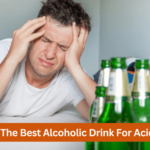I remember the first time I tried to make beer at home. I followed the recipe step-by-step, carefully measuring each ingredient and following the instructions to the letter. But when it came time to use the hydrometer, I was stumped. I had never used one before, and the instructions seemed complicated and confusing. It wasn’t until I learned how to use a hydrometer that I truly understood the science behind brewing beer. Whether you’re making beer, wine, or testing battery fluid, knowing how to use a hydrometer is essential. In this article, I’ll guide you through the basics of hydrometer reading, step-by-step instructions, and advanced techniques to help you master the art of using a hydrometer.
What is a Hydrometer Used to Measure?
A hydrometer is a device that measures the density of a liquid in relation to water. It typically consists of a graduated glass tube with a weighted bulb at one end that is used to determine the specific gravity or density of a liquid sample.
Understanding the Basics of Hydrometer Reading
Understanding the basics of hydrometer reading is essential for obtaining accurate measurements. Here are some key factors to consider:
- Gravity and density: A hydrometer measures the density of a liquid in relation to water. This is often referred to as specific gravity. Gravity is the force that pulls objects towards each other, while density refers to how tightly packed the molecules in a substance are.
- Temperature’s impact on hydrometer reading: Temperature can affect the density of a liquid, which can in turn affect the accuracy of a hydrometer reading. It is important to take temperature into account when measuring with a hydrometer.
- Measuring with a graduated cylinder: A graduated cylinder is a laboratory tool used to measure the volume of a liquid. When using a hydrometer, it is important to measure the liquid in a graduated cylinder to ensure accuracy.
- Preparing the sample: The liquid being measured should be well mixed and free from any bubbles or debris that could affect the density measurement.
- Reading the meniscus: When measuring a liquid in a graduated cylinder, the meniscus (the curved surface at the top of the liquid in the cylinder) should be read at eye level to ensure accurate measurement. The bottom of the meniscus indicates the liquid’s surface level, and this is where the hydrometer reading should be taken.
By taking these factors into account, you can ensure accurate and reliable measurements with your hydrometer.
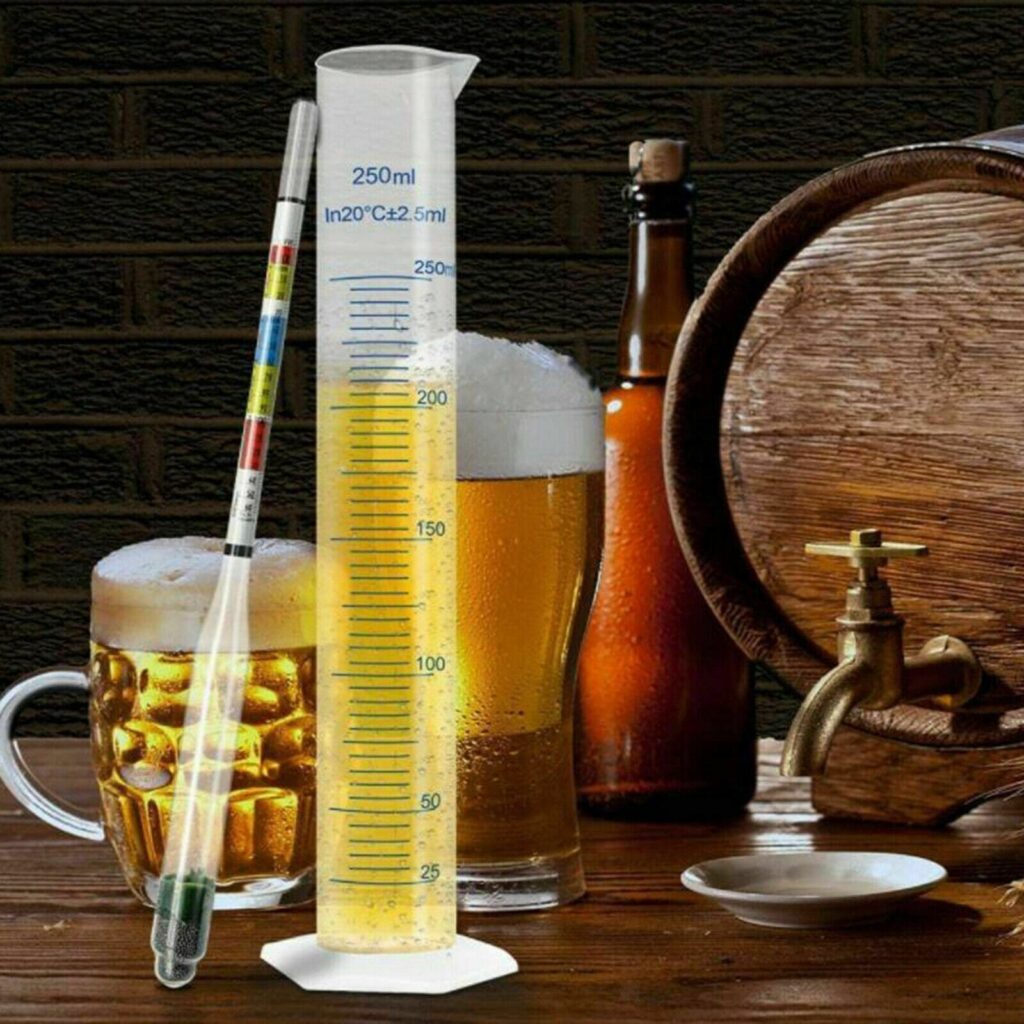
How Does a Hydrometer Work?
Here are the key steps involved in how a hydrometer works:
- The hydrometer is placed in a liquid sample, and it floats based on the density of the liquid.
- The weight of the hydrometer is concentrated in the lower bulb, which allows it to float upright in the liquid.
- The hydrometer is calibrated to a specific scale, which allows for the measurement of the specific gravity or density of the liquid.
- The hydrometer sinks deeper into liquids with higher density and floats higher in liquids with lower density, and the level at which it floats is read at the meniscus line.
- The temperature of the liquid can affect the density of the liquid, so it is important to account for this in the hydrometer reading.
What’s a Hydrometer Used for?
A hydrometer is a versatile tool that is commonly used to measure the specific gravity or density of liquids. It is widely used in various fields, including:
- Brewing beer and making wine
- Measuring the state of charge in batteries
- Testing engine coolant concentration
- Checking the concentration of salt in aquariums and swimming pools
- Measuring the density of urine in medical testing
- Monitoring chemical reactions in laboratories
In summary, hydrometers are used to measure the density of liquids in a variety of applications.
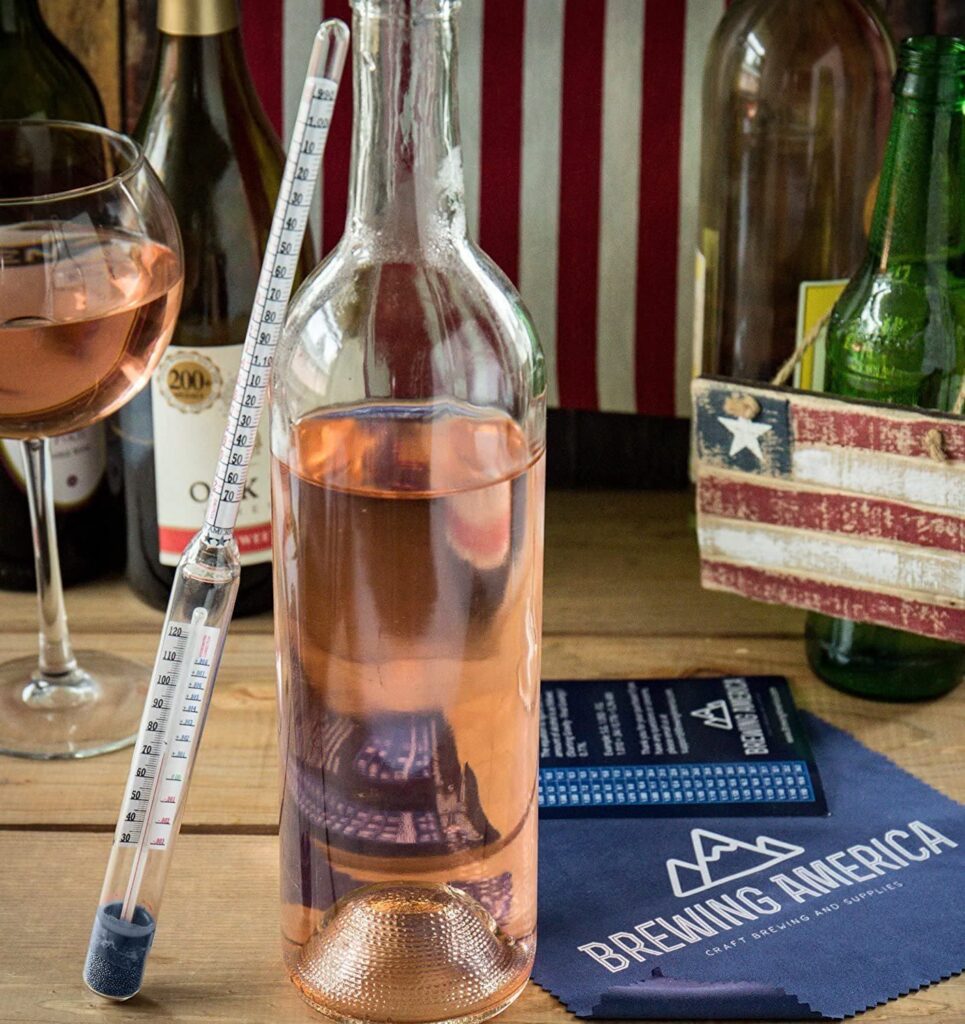
How to Use a Hydrometer
Learning how to use a hydrometer is crucial for obtaining accurate measurements of liquid density. Here is a step-by-step guide on how to use a hydrometer for wine, beer, and spirits.
Retrieve the sample and insert hydrometer
Start by retrieving a sample of the liquid you want to measure and pour it into a clean and sanitized container. Then, carefully insert the hydrometer into the liquid, making sure it is floating freely.
Obtain the original gravity reading
Take a reading of the liquid’s specific gravity or density by reading the scale where the hydrometer is floating. This is known as the original gravity (OG) reading. Make sure to take the reading at the meniscus, which is the curved surface at the top of the liquid.
Calculate with temperature
Since the density of the liquid can vary with temperature, it’s important to take temperature into account to get an accurate reading. Use a thermometer to measure the temperature of the liquid and adjust the reading according to the hydrometer temperature correction chart.
Repeat to obtain the final gravity reading
After the liquid has undergone a process, such as fermentation or distillation, take another reading using the same process as before. This is known as the final gravity (FG) reading.
Calculate ABV
To calculate the alcohol by volume (ABV), subtract the FG from the OG, then divide the result by 7.36. The resulting number is the ABV percentage.
Clean and store
After using the hydrometer, clean it thoroughly with warm water and allow it to air dry. Store it in a safe place where it won’t be damaged.
By following these steps, you can accurately use a hydrometer to measure the specific gravity or density of a liquid and determine its alcohol content.
How to Read a Hydrometer
Reading a hydrometer is a simple process that involves a few basic steps. Here’s a quick summary:
- Retrieve a sample of the liquid you want to measure and pour it into a container.
- Insert the hydrometer into the liquid and make sure it is floating freely.
- Take a reading of the specific gravity or density of the liquid by reading the scale where the hydrometer is floating. Make sure to take the reading at the meniscus, which is the curved surface at the top of the liquid.
- Adjust the reading for temperature, if necessary, using a hydrometer temperature correction chart.
- If taking multiple readings, repeat the process and calculate an average for accuracy.
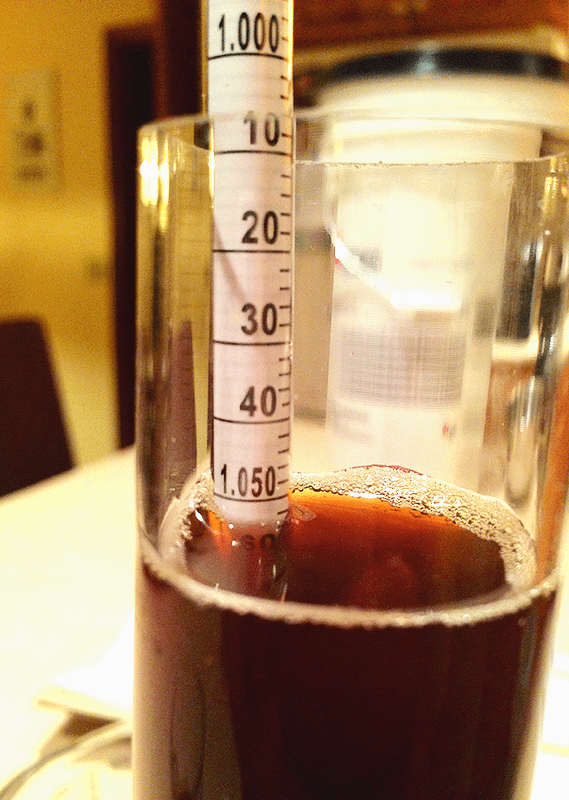
Why Do I Need A Hydrometer To Make Alcoholic Drinks?
Here are some reasons why a hydrometer is essential for making alcoholic drinks, such as: beer, wine and spirits:
- Measure specific gravity: A hydrometer is used to measure the specific gravity of the liquid during the brewing or distillation process. This helps in determining the alcohol content of the finished product.
- Determine fermentation progress: The hydrometer can be used to monitor the progress of fermentation by taking readings at different stages. This helps in determining when fermentation is complete and the alcohol content is at the desired level.
- Ensure consistency: Using a hydrometer can help in ensuring consistency in the alcohol content of the finished product. This is especially important for commercial brewing or distilling, where consistency is key to maintaining product quality.
- Adjust recipes: By measuring specific gravity, a hydrometer can help in adjusting the recipe to achieve the desired alcohol content or flavor profile.
So, a hydrometer is an essential tool for making alcoholic drinks, as it helps in ensuring consistency and accuracy in the alcohol content of the finished product.
Hydrometer Temperature Correction Chart
| Temperature (°C) | Correction Factor (ΔG) |
| 0 | 0.0007 |
| 1 | 0.0008 |
| 2 | 0.0008 |
| 3 | 0.0009 |
| 4 | 0.0009 |
| 5 | 0.0009 |
| 6 | 0.0008 |
| 7 | 0.0008 |
| 8 | 0.0007 |
| 9 | 0.0007 |
| 10 | 0.0006 |
| 11 | 0.0005 |
| 12 | 0.0004 |
| 13 | 0.0003 |
| 14 | 0.0001 |
| 15 | 0 |
| 16 | 0.0002 |
| 17 | 0.0003 |
| 18 | 0.0005 |
| 19 | 0.0007 |
| 20 | 0.0009 |
| 21 | 0.0011 |
| 22 | 0.0016 |
| 23 | 0.0016 |
| 24 | 0.0018 |
| 25 | 0.0021 |
| 26 | 0.0023 |
| 27 | 0.0026 |
| 28 | 0.0029 |
| 29 | 0.0032 |
| 30 | 0.0035 |
| 31 | 0.0038 |
| 32 | 0.0041 |
| 33 | 0.0044 |
| 34 | 0.0047 |
| 35 | 0.0051 |
| 36 | 0.0054 |
| 37 | 0.0058 |
| 38 | 0.0061 |
| 39 | 0.0065 |
| 40 | 0.0069 |
| 41 | 0.0073 |
| 42 | 0.0077 |
| 43 | 0.0081 |
| 44 | 0.0085 |
| 45 | 0.0089 |
| 46 | 0.0093 |
| 47 | 0.0097 |
| 48 | 0.0102 |
| 49 | 0.0106 |
How to Measure Alcohol Content Without a Hydrometer?
While a hydrometer is the most accurate tool for measuring alcohol content, it is possible to estimate alcohol content without one. Here are some methods:
Refractometer
A refractometer is a tool that can be used to measure the sugar content in a liquid, which can be used to estimate alcohol content. However, this method is less accurate than using a hydrometer.
Alcoholmeter
An alcoholmeter is a similar tool to a hydrometer but is specifically designed to measure alcohol content. However, it may not be as accurate as a hydrometer and is less versatile in its applications.
Online calculators
There are many online calculators that use the initial and final gravity readings to estimate alcohol content. However, these estimates may not be as accurate as using a hydrometer.
Note that while these methods can provide an estimate of alcohol content, they may not be as accurate as using a hydrometer. If precision is important, it is recommended to use a hydrometer for measuring alcohol content.
Common Mistakes to Avoid When Using a Hydrometer
Here are some common mistakes to avoid when using a hydrometer:
- Overfilling the hydrometer: Filling the container too high can cause the hydrometer to sink too deep and give a false reading.
- Reading the wrong scale: Many hydrometers have multiple scales for different applications. Make sure to use the correct scale for your specific measurement.
- Ignoring temperature: Temperature affects the density of liquids, so it’s important to take the temperature of the liquid into account when using a hydrometer. Not adjusting for temperature can result in inaccurate readings.
- Not cleaning the hydrometer: Any debris or residue on the hydrometer can affect the reading. Make sure to clean the hydrometer thoroughly before each use.
- Not taking multiple readings: To ensure accuracy, it’s recommended to take multiple readings and calculate an average.
By avoiding these common mistakes, you can ensure accurate and reliable measurements when using a hydrometer.
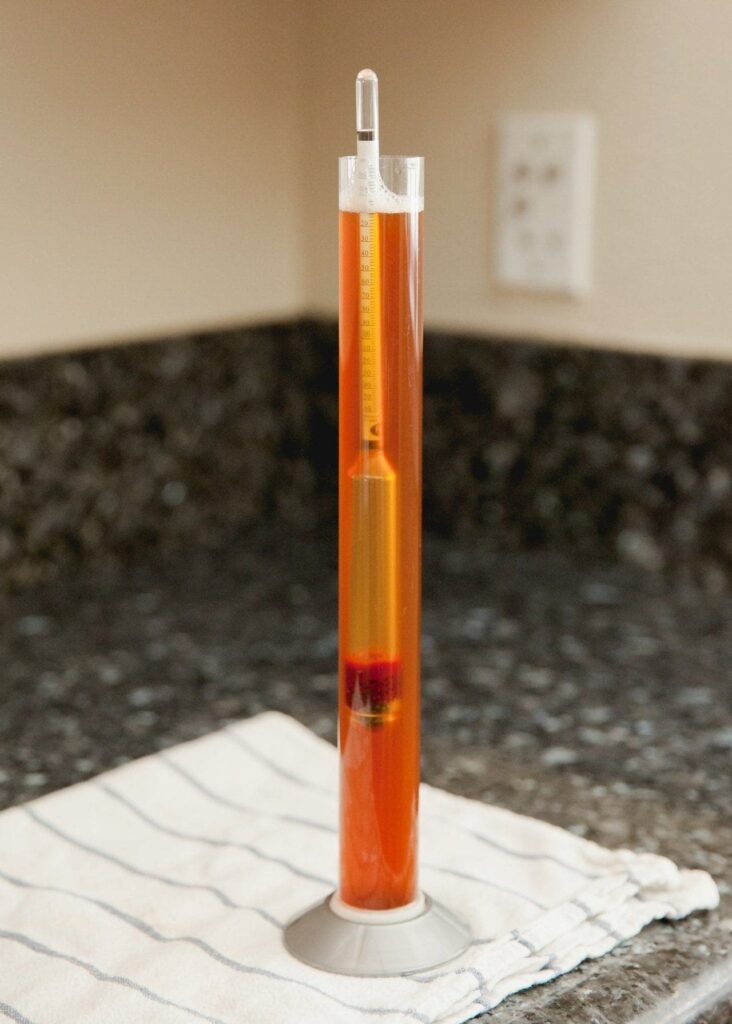
Tips for Using a Hydrometer
A hydrometer may be used effectively by following these following tips:
- Use a clean and sanitized container: Make sure the container you use to hold the liquid sample is clean and sanitized to avoid contamination.
- Avoid bubbles: Bubbles in the liquid can affect the density and give inaccurate readings. Ensure the liquid is free from bubbles before taking a reading.
- Use a graduated cylinder: A graduated cylinder can provide a more accurate measurement of the liquid volume, which can help in obtaining accurate readings.
- Read at eye level: When taking a reading, make sure to read the scale at eye level to avoid parallax errors and ensure accuracy.
- Adjust for temperature: Temperature affects the density of liquids, so it’s important to adjust for temperature using a hydrometer temperature correction chart.
- Take multiple readings: To ensure accuracy, take multiple readings and calculate an average.
Advanced Hydrometer Techniques
Here are some advanced hydrometer techniques:
- Calculating the alcohol by volume (ABV) using differential readings: This involves taking readings at multiple stages of the brewing or distilling process and using the differential to calculate the ABV more accurately.
- Using a digital hydrometer: Digital hydrometers can provide more accurate readings and may have additional features like temperature compensation.
- Measuring dissolved oxygen: Hydrometers can also be used to measure dissolved oxygen in the liquid sample, which can be important for maintaining product quality.
- Using a colorimeter: Colorimeters can be used to measure the color of the liquid, which can provide information about the malt or grain bill used in brewing.
These advanced techniques require additional equipment or knowledge and may be more appropriate for experienced brewers or distillers.
How Much Does a Hydrometer Cost?
The cost of a hydrometer can vary depending on the type, quality, and brand. In general, a basic glass hydrometer can cost anywhere from $5 to $20, while more advanced digital models can cost upwards of $100.
In addition, specialty hydrometers designed for specific applications, such as testing battery acid or aquarium water, can have different price points. The cost of a hydrometer is also affected by the location and the store from which it is purchased.
Differences Between an Alcohol Meter and a Hydrometer
| Alcohol Meter | Hydrometer | |
| Purpose | Used to measure the alcohol content | Used to measure the specific gravity or density |
| Measurement | Measures alcohol content directly | Measures specific gravity and requires calculations to determine alcohol content |
| Scale | Typically has one scale for alcohol content | May have multiple scales for different applications |
| Material | Made of glass or plastic | Made of glass, plastic or metal |
| Accuracy | Generally more accurate than a hydrometer for alcohol content | Generally more accurate than an alcohol meter for specific gravity |
| Application | Used specifically for measuring alcohol content | Widely used for various applications such as brewing, winemaking, testing battery acid, etc. |
| Cost | Generally more expensive than a hydrometer | Generally less expensive than an alcohol meter |
| Maintenance | Requires regular calibration and maintenance | Requires cleaning and proper storage to prevent damage |
FAQs
What is 1.025 on hydrometer?
A reading of 1.025 on a hydrometer typically indicates a liquid with a specific gravity of 1.025, which is commonly found in seawater.
What happens if hydrometer floats too high?
If the hydrometer floats too high, it may give a false reading, as the liquid level may be below the calibrated part of the scale. This can result in inaccurate readings and incorrect calculations.
Can a hydrometer be wrong?
Yes, a hydrometer can be wrong if it is not calibrated properly, damaged or used incorrectly. It is important to regularly calibrate and maintain the hydrometer to ensure accurate readings.
Does sugar affect hydrometer?
Yes, sugar can affect hydrometer readings, as it increases the density of the liquid. This can result in a higher reading on the hydrometer, which can lead to an incorrect calculation of alcohol content.
What are the cons of hydrometer?
The cons of hydrometer include the need for calibration, temperature correction, and the potential for inaccurate readings due to user error or other factors. It also requires a larger sample volume compared to other measuring tools, which may be a concern in certain applications.
Who uses a hydrometer?
Hydrometers are used by a variety of industries, including brewing, winemaking, distilling, chemical engineering, and medical testing.
How long does it take for a hydrometer to get an accurate reading?
It typically takes a few minutes for a hydrometer to settle and obtain an accurate reading. However, this may vary depending on the liquid being measured and the specific hydrometer used.
Where is the best place to put a hydrometer?
The best place to put a hydrometer is in a clean and sanitized container with enough liquid to allow it to float freely. It is also important to take the reading at eye level for accuracy.
Can you use a hydrometer without a test jar?
While a test jar can provide a more accurate reading, it is possible to use a hydrometer without a test jar. However, it is important to ensure the container used is clean and the hydrometer can float freely.
What temperature should you use a hydrometer?
The temperature of the liquid being measured should be taken into account when using a hydrometer, as temperature affects the density of the liquid. The hydrometer temperature correction chart can be used to adjust the reading for temperature.
Conclusion
Generally, learning how to use a hydrometer can be an essential skill for those involved in brewing beer, making wine, testing battery fluid, and checking engine coolant. Personally, I have found that using a hydrometer has greatly improved the quality of my home-brewed beer, allowing me to achieve the desired alcohol content and flavor profile. By understanding the basics of hydrometer reading, avoiding common mistakes, and following the step-by-step guide, anyone can learn how to use a hydrometer effectively. With practice and patience, you too can become an expert in reading this simple yet powerful tool, unlocking the secrets of your liquids’ gravity and density.
I’m Chen Mina, from Vol de Nuit, who has a special passion for bartending, especially mixing wine, beer, and cooktail. Here you will find content about alcoholic beverages, I will bring you knowledge that few people know about this drink.


